|
|
|
|
|
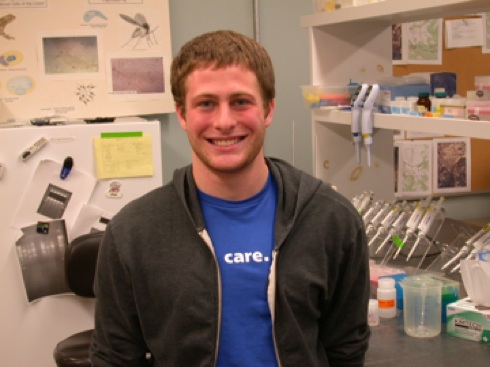 |
Max Ross Senior Undergraduate Research Student University of Vermont e-mail Max |
|
|
Max received his Biology degree in May 2014, with a History minor, He was a student in the Ecological Parasitology course in his Junior year and more-or-less moved into the research lab to help with research on Monocystis. He then wrote a proposal for a summer research fellowship from the university and was one of only a very few awarded! Max just about lived in the lab all summer, and moved on to his Senior research project in the fall. Max is one of those researchers with the magic touch: everything he works on in the lab yields great results. For his Senior research project, Max worked closely with Allison Neal on the genetic diversity of the sandfly vector of Plasmodium mexicanum using microsatellite markers. Allison and Max developed a panel of markers that give very clean data (at least, they are always clean for Max). The project asks if there is geographic variation in the sandfly over small spatial scales, and seeks to give some information on the population size of the insect. A puzzle at the California research site is the very patchy distribution of the malaria parasite in lizards; Sites only a few hundred meters apart may have infected lizards, and the others with no malaria -- and this pattern has been seen for over 30 years. This suggested the vector may move very little, and thus opens the door for local genetic differentiation. A paper from that study is now in review at a major journal.
Besides making himself invaluable in the lab, and getting great data, Max was also on the university gymnastics team, and traveled the country to compete in major competitions. So, when he was not deftly handling tiny drops of fluid in the lab, he was flying through the air on the high rings. Max will continue with gymnastics after graduation, and also plans to attend graduate school in biology. But, he is now taking time off to work in a major biology research laboratory as a master technician.
|
||
 |
Leslie Barnard Senior Undergraduate Research Student University of Vermont e-mail Leslie |
|
| Leslie, Max, and Dr. Schall all first connected when Leslie and Max were in the honors section of Schall's introductory biology course in their first semester at UVM. Leslie went on to work in Dr. Sara Helms Cahan's lab (ant ecology and evolution), but decided to try something different for her Senior year, and so came to the malaria lab. Leslie already had outstanding lab skills from her time in the ant lab, and so very quickly became an important member of the lab, and stepped up to help Max with his sandfly work. Leslie ended up pretty much living in the lab to help push the work along at an even faster pace. For her final semester, Leslie worked on her own project, a look at the variation in the flanking regions for the microsatellite markers. Leslie was a Biology major with minors in Chemistry and Nutrition. Outside of research and academics, Leslie is a competitive shooter! She shoots skeet and trap (trap involves two targets in the air at once, one of the toughest challenges in shooting). During her senior year, Leslie traveled to the East Coast College Championships at George Mason University where almost 200 students competed over a two day period (100 shots each for trap and skeet each day). Leslie placed first among women, and fourth overall! Then, Leslie went for broke competing in the major US College competition and placed first again among women and second only to a shooter from West Point! Leslie's plans a career in public health and now is in the gradaute program in Public Health at Tulane University. | ||
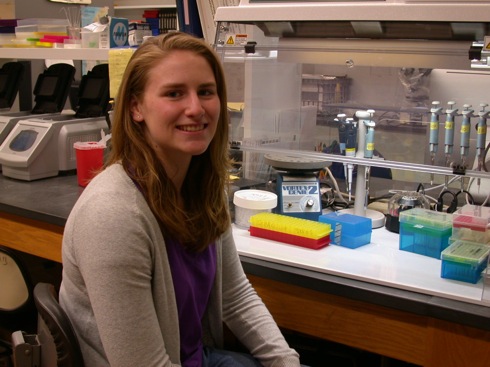 |
Megan Lind Undergraduate Honors Student University of Vermont e-mail Megan |
|
|
Megan graduated in May, 2013 and was in the Honors College and one of our outstanding majorst. Megan joined us in her Sophomore year, and completed her Senior Honors project in the lab. From her first days in the lab, Megan proved to be a Jill-of-all-trades, working on a wide variety of studies, including a survey of the white blood cell classes of lizards, the genetic diversity of Plasmodium mexicanum, and developing variable genetic markers for a sand fly species, including RAPDs and microsatellites. In addition to being a skilled laboratory researcher, Megan spent two summers at the California field site working with Dr. Anne Vardo-Zalik of Penn State University on the sand fly vector of P. mexicanum. Megan's work was honored with a summer APLE fellowship, one of only only a few awarded each year by College of Arts and Sciences. For her Honors project, Megan chose an ambitious research program. She sought to understand the genetic diversity of the malaria parasite, and asked if specific clones of the parasite are more or less likely to occur in mixed-clone infections than others, the first time this has been done for any malaria parasite. Gathering the data involved extensive field work and then a huge number of hours in the lab getting the data on clones within infected lizards. The next big problem was how to analyze the data. Megan chose to use new statistical methods worked on by our Dr. Nick Gotelli to understand how species occur in communities in positive, negative, or neutral associations. The software proved powerful, and gave beautiful insights into how parasite clones may interact. This was the first time the new statistical method was used to examine genetic data. Her result is now in preparation for submission to a major journal. As an undergraduate, Megan blended interests she inherited from her parents: a planned career in medicine (her father is a cardiologist) and fencing (her mother was a varsity fencer as an undergraduate). Megan has competed in fencing at the national level, third one year, and in her Senior year she placed first in the nation in her event. We had a national champ in the lab! We tried not to make jokes about the a medical professional who can stab 'em and then treat 'em (OK, that was a joke). Megan is now completing her program to become a Physician's Assistant. |
||
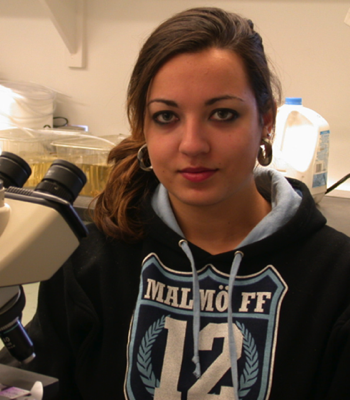 |
Annika Nilsson Undergraduate Research Student University of Vermont e-mail Annika |
|
| Annika was an Anthropology major and completed her Honors research program, with a thesis that took an anthropologist's perspective on birthing "treatment" in medical facilities. Her interests began early in life because Annika comes from a family involved in public health research and she has lots of world travel experience. Annika wisely sought us out to learn something about research methods in infectious disease, and was in the lab for two years. Annika worked closely with graduate student Allison Neal, helping both with the molecular studies and extracting lots of data from the microscope blood smears (old-fashioned counting of parasites), and became a very valuable member of the lab group. Annika's genotyping results proved so reliable that she became the lab's research assistant for two years, in 2012 and 2013, producing excellent data for the ongoing studies of P. mexicanum genetic diversity. For Annika's Junior project she looked at the Plasmodium mexicanum gametocyte sex ratio at sites where the parasite is common vs. rare to test one prediction from sex ratio theory (that high prevalence means high clonal diversity and thus a less female-biased sex ratio). Annika also worked in training another undergrad in the lab. The study is now in preparation for submission to a journal in parasitology. Annika's career has taken an unusual turn: she is in training to be a tattoo artist! | ||
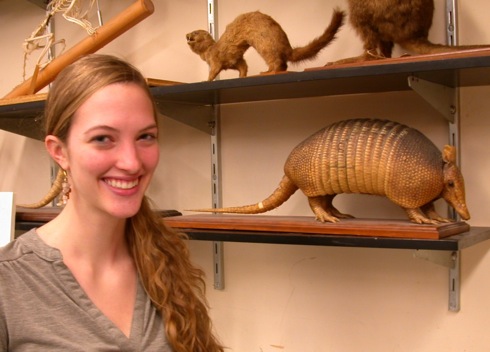 |
Krystina Kattermann Undergraduate Research Apprenticet University of Vermont e-mail Krystina |
|
| Krystina was "discovered" when she was a student in the introductory biology course for the top entering life science students taught by Schall. She did so well, that we lured her into the lab. Krystina is a Microbiology and Molecular Genetics major with a medical career in her future. During her first semester as a Research Apprentice, Krystina helped in a variety of lab duties, and in her second semester she worked with graduate student Alli Neal's study of gametocyte sex ratio at sites where the malaria parasite is common vs. rare. Krystina is an avid athlete, competing in downhill skiing in high school, and now swimming here at UVM. But, she has moved now into a lab in our Micorbiology and Molecular Genetics Department where she did her Senior Honors research. | ||
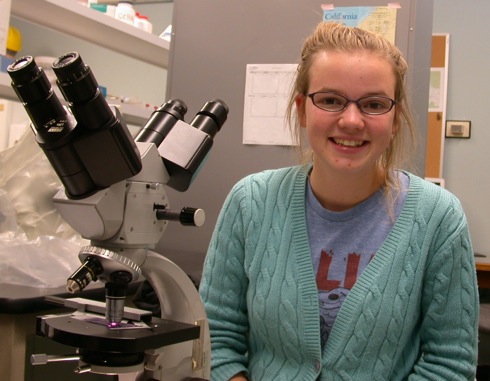 |
Leah Rogstad Undergraduate Honors Student University of Vermont e-mail Leah |
|
| Leah joined the lab in the spring 2013 semester. She was a student in our introductory biology course offered for the top entering life science majors taught by Dr. Schall. She did so well that we threw out bread crumbs to lead her into the lab. Leah is interested in a career in public health and international development (and thus is a Global Studies major), and seemed a perfect match for the lab (infectious disease!). She is working with our other public health fan, Annika Nilsson. Leah has now moved into the laboratory of Dr. Lori Stevens to work on tropical parasitology and medical entomology Leah is fluent in Spanish and has spent long periods in Latin America. | ||